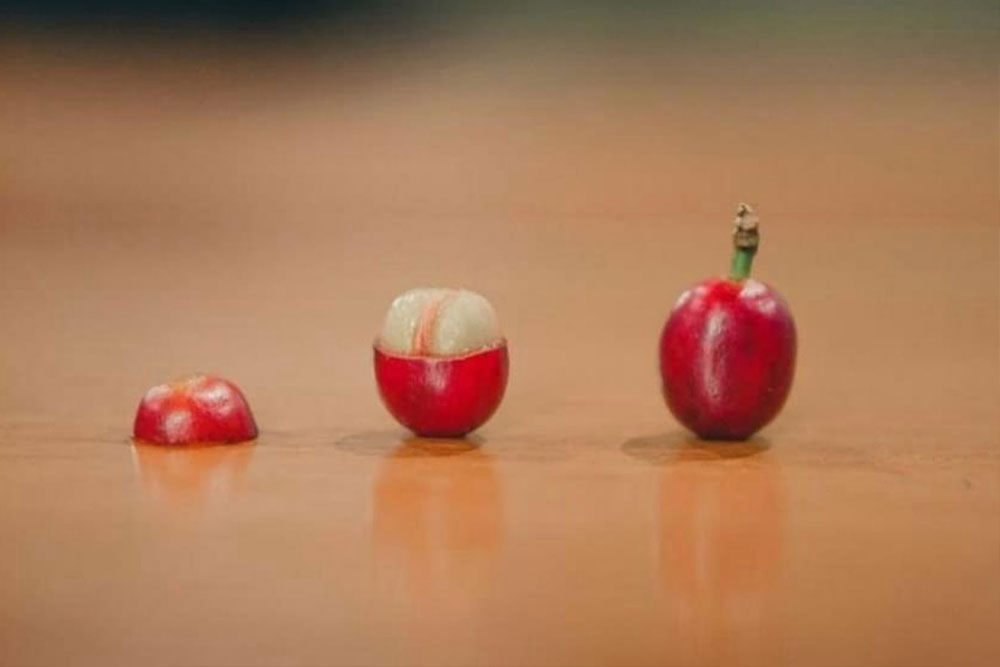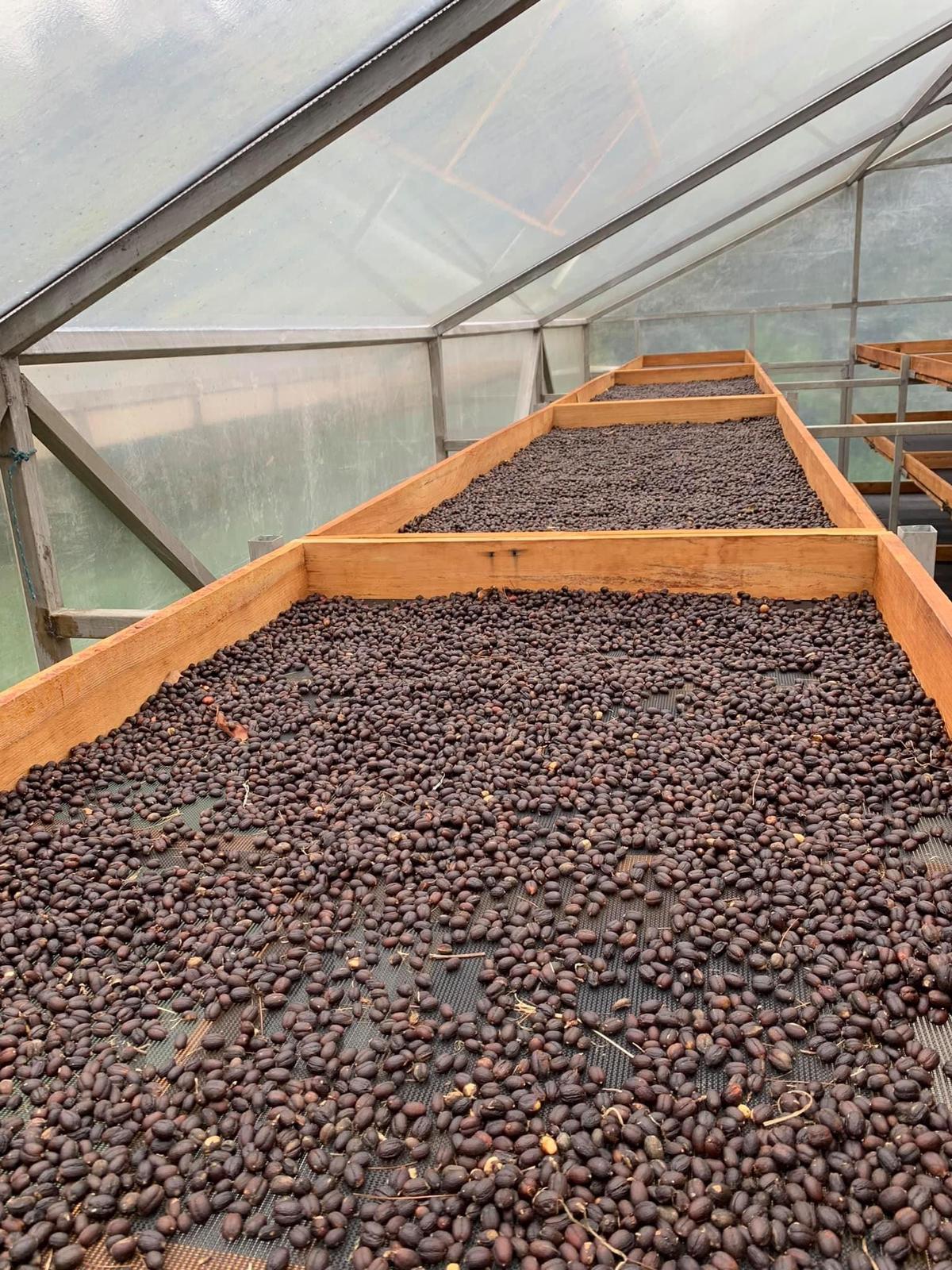The processes of green coffee processing

The processing of green coffee concerns the post-harvest phases of cherries that, before being shipped, require a specific treatment.
Currently, there are several methods of processing. However, we avoid defining them as fixed rules; rather, we can consider them as real "recipes", subject to continuous research and experimentation in all producing countries. It is like saying that every pastry chef in the world has his "secret recipe" for a specific dessert.
Each method is unique, and the use of each approach will have a distinctive impact on each variety of coffee, influencing its quality: Body - Taste - Flavor.
Process of natural processing:
The process of natural processing is the oldest technique for processing coffee, provides for the drying of the whole cherry and can take place on special patios or African bed to ensure a more homogenous drying and refers to the specialty coffee.
The coffee, still with the whole cherry, is left to dry for about 15/25 days with the aim of reducing humidity to about 11%. Although it may seem like a simple technique, it is actually very complex. Avoid unwanted overfermentations and mold requires constant mixing of coffee. These cherries are constantly at risk of deterioration; as soon as they are stored for drying, a natural fermentation begins due to the organic material of the fruit.
Once the coffee has dried properly, it is transferred to remove the peel, pulp and pergamin. Depending on the quality, it could be further selected manually or mechanically, and then placed in special jute bags for shipment.
The working process "Washed"
Among the various post-harvest processes, the "Washed" method is the fastest and is used in some producing regions of Africa, America and Asia, although it is rare in Brazil.
After harvesting, some manufacturers use the "flotation" technique for further selection based on specific weight, eliminating the cherries that float and are therefore considered defective.
In this process, a few hours after harvesting, the cherry is mechanically separated from the grain by special machines, usually within 8-12 hours of harvesting. After stripping (mechanical separation), the grains are still covered with a part of the mucilage.
The remaining mucilage on the grain is partially removed through a further passage of "washing". The seeds, now sticky, are transferred to fermentation tanks. This phase helps to soften the residual mucilage to facilitate its removal. The next day is the actual washing, immersing the beans in cool water and removing the residual mucilage (creating a cloudy water). This step can be repeated several times, and in some countries such as Peru, Colombia and Costa Rica it is common to use additional riddles to eliminate defective grains.
The beans are placed on patios or african bed for 1/2 weeks, depending on the weather. During this phase, the grain still retains the pergamino and is transferred to the warehouse of "seasoning" to then remove the pergamino and be ready for shipment.
Washed coffee left to dry
This is just one of several techniques of defining washed coffee, and it is not to be defined universal.
Another method of processing green coffee is the Honey Process. This method is widely appreciated in most of Central America, with particular attention dedicated at Costa Rica ed El Salvador. In many respects, the Honey process bears similarities to the Brazilian Pulped Natural method. The main distinction of this process is the removal of the peel only. As in the washed process, only ripe cherries are selected. Another element in common with the washed method is the rapid separation of cherries from the skin, which took place within 8-12 hours of harvesting.
The main distinction of this process is the removal of the peel only. As in the washed process, only ripe cherries are selected. Another element in common with the washed method is the rapid separation of cherries from the skin, which took place within 8-12 hours of harvesting.
In this way the coffee bean is obtained without peel and pulp, but still covered with mucilage, a substance with the characteristics of molasses. Reducing the Honey process to a single definition would be limiting, since Honey represents a branch of the various sensory possibilities that this method offers.
The Honey process can be divided into several categories:
-
Black Honey
-
Red Honey
-
Yellow Honey
The name comes from the percentage of residual mucilage attached to the grain and the specific conditions of drying, considering whether it takes place in full sun exposure, in semi-darkness or in total shade, and at what hours of the day. Typically, the drying period takes about 2/3 weeks to reach a humidity of about 11%.
Once the coffee has been successfully dried, it is stored with the pergamino until the shipping date. It should be noted that the world of machining processes is extremely vast and in constant experimentation.
The Anaerobic Fermentation
(A period of time with little oxygen)
In recent years, anaerobic fermentation has emerged as one of the fastest growing processes. This approach has led manufacturers to diversify over time, creating a distinctive and personalized product. In this methodology, fresh coffee is placed in a specially designed and hermetically sealed container. During this phase, the fermenting fruit releases carbon dioxide, which fills the empty space in the container, pushing the oxygen originally present outwards. This creates an environment with a very low oxygen content, leading to a unique sensory profile compared to methods involving oxygen.
However, it is important to clarify that when we talk about "anaerobic", we are not defining a separate process, but an integral component of the overall process. Anaerobically fermented coffee does not reveal whether it has undergone variations during, before or after fermentation, such as the addition of yeasts or if it has experienced a partially anaerobic fermentation followed by a part with oxygen. This variety can include natural, honey or washed coffees, keeping the pastry chef’s analogy with his own "recipe".
Imagining this process inclusive step, we can consider:
-
Separation by floating in water to eliminate immature and defective cherries.
-
After a rigorous selection, whole cherries are placed in sealed tanks for 48-72 hours, depending on the Brix grade measured, but this phase can also extend to 7-10 days or more.
-
The beans are left to dry, following the natural process with the whole cherry, or they are despolpati and dried as in the honey method or washed to obtain an anaerobic washed coffee. All processes may include an anaerobic phase.
Ricerca Offerte
In Evidenza
Categorie
Parole più ricercate
Caffè freddo
Filiera Caffè
SCA
Crema al caffè
Fiere
Sigep 2024
Notizie dal mondo del caffè
Eventi caffè
Specialty Coffee
Expo caffè
Gambilongo Caffè
Fiere del caffè
Ricette a base di caffè
Estrazione
News
Fermentazione caffè
Latte Art
Azienda
Tendenze Caffè
Caffè Verde
Walkaround
Chiacchiere sul caffè
Su di noi
Processi di lavorazione
Mocktails e Bevande Fusion
A BIT OF US
Gambilongo Caffè was born in the sixties from the passion and experience that, handed down from generation to generation, led the company to establish itself, from the outset, distinguishing itself for the quality of the products and services offered.
INFORMATION
Gambilongo Caffè
Sesso Caffè
Academy
News
Contact
USEFUL LINKS
Privacy
Cookie Policy
Conditions of sale
Returns
Shipments
NB: All products available on the site are intended for sale to the public, excluding any retailer.
Gambilongo Caffè S.r.l. | PI: 02889690786 | REA n.cs-196685 | Cap. soc. € 10.000 i.v.
Via V. Bottego - C.da Lecco - 87036 Rende (CS)
(+39) 0984 402034
ufficio@caffegambilongo.it
Powered by Passepartout
